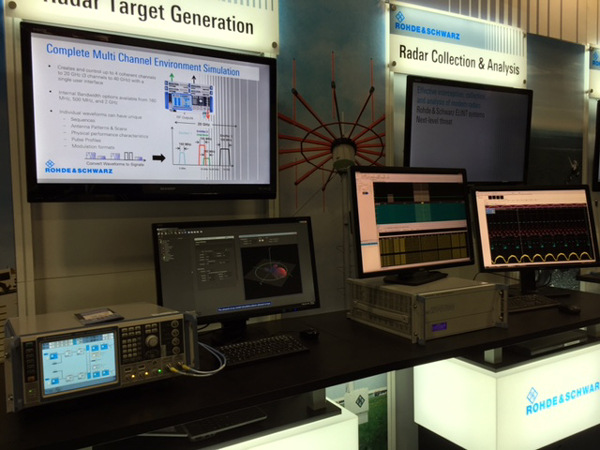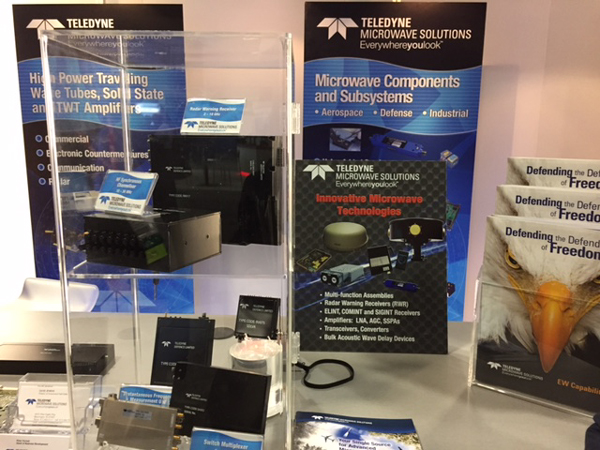This year was the 53rd Annual International Symposium and Convention for the Association of Old Crows (AOC) focusing on Electromagnetic Spectrum Operations and attended by international military leaders, policy makers and experts from the warfare industry. The event took place in Washington DC with the technical sessions covering research findings and increasing awareness of emerging technologies in the areas of electronic support, electronic attack, electronic protection, spectrum awareness and spectrum de-confliction.
The event featured discussions about the AOC International awareness and advocacy mission and how we will continue to advance the cause of EW/EMSO in the military. They also brought back the AOC STEM Program to help inspire the future leaders to become involved and be Young Crows. Even though this subject can be touchy with security concerns, the symposium draws an international crowd to share ideas and new concepts.
A fast growing system solution we have seen at many events this year is drone detection and location systems. Aaronia displayed one early this year at EDI CON China and at AOC, both Keysight and R&S were featuring these systems. Some are very impressive in that they not only detect and locate drones, but also can jam their signals and record their data transmission. Detection can be so fast that they can be jammed before takeoff preventing them from even getting airborne. We plan to do further reviews of this technology next year.
In the exhibition, we met with many of the RF/microwave companies and covered some of the products they were highlighting at the event:
 Analog Devices was featuring many component and sub-system solutions for broadband applications including their HMC8114, a 90 W GaN, MMIC power amplifier module that operates between 5.8 and 18 GHz, provided in an environmentally sealed chassis. The amplifier typically provides 68 dB of small signal gain and 49.5 dBm of saturated RF output power. The amplifier draws 1 kW of power from a 48 V DC supply. The RF input/outputs are dc blocked and matched to 50 ohms for ease of use.
Analog Devices was featuring many component and sub-system solutions for broadband applications including their HMC8114, a 90 W GaN, MMIC power amplifier module that operates between 5.8 and 18 GHz, provided in an environmentally sealed chassis. The amplifier typically provides 68 dB of small signal gain and 49.5 dBm of saturated RF output power. The amplifier draws 1 kW of power from a 48 V DC supply. The RF input/outputs are dc blocked and matched to 50 ohms for ease of use.
DRS Technologies (a Leonardo company) was featuring the SI-9173/CC-3 Vesper, a 6U conduction-cooled, VPX, 1-inch pitch, VITA 65-compliant tuner. The Vesper module accepts nine blind-mate antenna inputs (via a rear-panel VITA 67 interface) for nine high-performance Alpine tuner channels covering the 2 MHz to 6 GHz frequency range. The Vesper module also includes one exciter channel covering 2 MHz to 6 GHz. Each receive channel down converts incoming RF to an analog IF having up to 100 MHz of bandwidth. A selection of additional analog bandwidth filtering is available to reject large interfering signals and provide superior RF performance. Raw output data from an ADC is fed into a FPGA for time stamping, pre-processing (digital down conversion, filtering, and decimation if desired), and packetization in accordance with the VITA 49 VRT standard for transport via the Aurora protocol. Other transport protocols (such as PCIe Gen 2/3, Serial RapidIO or 10GigE) are available.
 Insulated Wire (IW) supplies RF and microwave cable assemblies, including composite assemblies, for demanding applications including EW. They have very low loss solutions like the 480 Series that operates up to 11 GHz with maximum attenuation ranging from .019 to .380 dB/m. Velocity of propagation is 83% and time delay is 1.22 ns/ft.
Insulated Wire (IW) supplies RF and microwave cable assemblies, including composite assemblies, for demanding applications including EW. They have very low loss solutions like the 480 Series that operates up to 11 GHz with maximum attenuation ranging from .019 to .380 dB/m. Velocity of propagation is 83% and time delay is 1.22 ns/ft.
Keysight Technologies demonstrated flexible and cost-effective commercial-based EW test and verification solutions including:
- Keysight-validated, performance-optimized multi-emitter scenarios with AoA capability
- Metrology grade statistical pulse train and dual rate jammer analysis
- 50 GHz handheld SA with real-time spectrum analysis
- SystemVue software solution with phased array beamforming modeling and analysis
- Portable COMINT solution
Their drone detection and location system uses RF sensors that can be networked over an area for full coverage and protection with automated software to detect emitters and classify them. It can also capture data over a period of time and perform analysis.
Mercury Systems was featuring their sub-systems such as the RFM-1R1S18Ks, the latest series of scalable, single-channel tuners with wideband front-ends. Equally suited to new EW applications and modernizations, these low-latency configurations are open systems architecture (OSA) solutions comprised of three OpenRFM™ RF/Microwave building blocks, packaged as single-width, 6U VXS modules. OpenRFM standardizes the electromechanical, software, control plane and thermal interfaces used by integrated microwave assemblies to streamline the design and integration of RF and digital capabilities within sensor processing subsystems. Standard interfaces leverage IP re-use across applications to drive overall investment value, efficient SWaP-C utilization and expedited time-to solution/market.
 The Microwave Products Group (a Dover Company) is made up of well-known brands including Dow-Key Microwave, K&L Microwave, BSC Filters and Pole Zero. They offer a wide range of microwave filters; high-performance, low insertion loss switches; and integrated cosite equipment for eliminating interference in military communications systems.
The Microwave Products Group (a Dover Company) is made up of well-known brands including Dow-Key Microwave, K&L Microwave, BSC Filters and Pole Zero. They offer a wide range of microwave filters; high-performance, low insertion loss switches; and integrated cosite equipment for eliminating interference in military communications systems.
Planar Monolithics Industries was featuring many microwave products including an interesting proposal for solid-state technology for identifying and jamming, spoofing, and hijacking of agile autonomous drones. It consists of a RF module, acoustic module and “Janus” fiber effectors. This is a DARPA proposal that will be very interesting to follow in development, if accepted.
Qorvo was featuring their Spatium® RF power combining technology provides a highly reliable, efficient alternative to TWTAs for commercial and defense communications, radar and EW. Spatium solutions are customizable and improve broadband RF power and efficiency through patented coaxial spatial combining techniques using GaAs or GaN MMIC amplifiers. The solid-state construction enables longer service lifetimes than comparable TWTAs or conventional planar power combining products. They also provide size, weight and power (SWaP) advantages.
 R&S was featuring many EW solutions including their drone detection and location system. It includes:
R&S was featuring many EW solutions including their drone detection and location system. It includes:
- Fast response: detection, identification, directing finding and jamming of threats in less than 20 sec, including the decision time by the operator. Capable of identifying the radio control emission of the drone immediately after switching on (even before take-off)
- Frequency range: covers all the relevant frequencies used by modern drones 433 MHz, 2.4 GHz, and 5.8 GHz
- Automatic workflow: online detection of frequency-agile short-time signals, hop analysis, classification of hop parameters (i.e. hop duration, hop rate, modulation and other parameters)
- Excellent time resolution: min burst duration = 500 µs
- Wideband hopper detection: max hopper bandwidth = 2.5 MHz
- Wideband direction finding: max realtime bandwidth = 80 MHz
- Advanced DF: multi-element direction finding antennas with superior DF accuracy, sensitivity and immunity to reflections
- Effective jamming: advanced exciter for jamming purpose, only the radio controlled drone signal should be jammed and other legal signals in the same band should not be affected
- Automatic IQ recording: IQ recording for detailed analysis of the recorded complex signal scenarios by technical signal analysis software to explore new types of drones. Concurrently, it also conserves as the assurance of evidence
 Teledyne Microwave Solutions has many EW products such as broadband amplifiers; TWTAs and assemblies; tunable YIGs and filters; frequency generation products; integrated microwave assemblies; and receivers and threat warning products. They were featuring several products such as the PHOBOS-R, which is a compact size, weight & power (SWaP) and cost effective threat warning receiver system designed to minimize installation, training, operation, maintenance and life cycle costs of ESM systems. The PHOBOS family of Threat Warning and ESM systems includes options for enhanced performance, frequency extension, multiple port configuration and pulse analysis tools for real time and off line signal analysis.
Teledyne Microwave Solutions has many EW products such as broadband amplifiers; TWTAs and assemblies; tunable YIGs and filters; frequency generation products; integrated microwave assemblies; and receivers and threat warning products. They were featuring several products such as the PHOBOS-R, which is a compact size, weight & power (SWaP) and cost effective threat warning receiver system designed to minimize installation, training, operation, maintenance and life cycle costs of ESM systems. The PHOBOS family of Threat Warning and ESM systems includes options for enhanced performance, frequency extension, multiple port configuration and pulse analysis tools for real time and off line signal analysis.
Times Microwave was featuring many cable products including their SilverLine™ Test Cables which are cost effective, durable, high-performance cable assemblies designed for use in a broad range of test and interconnect applications. Fabricated from rugged, solid PTFE dielectric cable with stainless steel connectors and a proven strain relief system, these cables provide long life and excellent stability in applications where they are repeatedly flexed and mated/unmated. SilverLine™ test cables are ideal for use in production, field and laboratory test environments. They are also economical enough to be used as interconnects in test systems.
Here is a link to our complete photo gallery.

